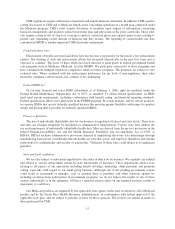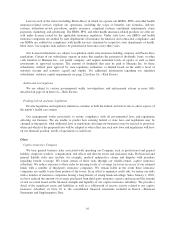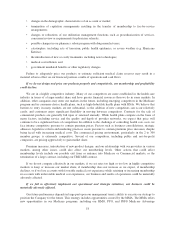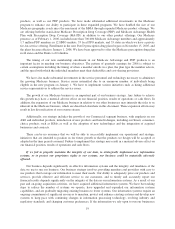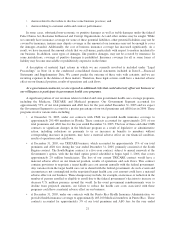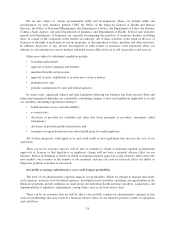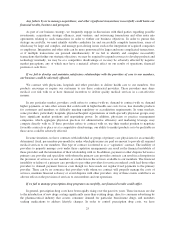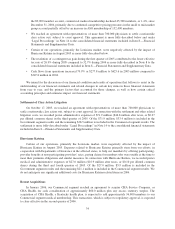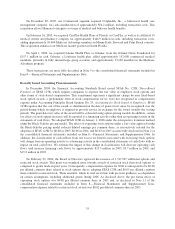Humana 2005 Annual Report Download - page 35
Download and view the complete annual report
Please find page 35 of the 2005 Humana annual report below. You can navigate through the pages in the report by either clicking on the pages listed below, or by using the keyword search tool below to find specific information within the annual report.Any failure by us to manage acquisitions, and other significant transactions successfully could harm our
financial results, business and prospects.
As part of our business strategy, we frequently engage in discussions with third parties regarding possible
investments, acquisitions, strategic alliances, joint ventures, and outsourcing transactions and often enter into
agreements relating to such transactions in order to further our business objectives. In order to pursue this
strategy successfully, we must identify suitable candidates for and successfully complete transactions, some of
which may be large and complex, and manage post-closing issues such as the integration of acquired companies
or employees. Integration and other risks can be more pronounced for larger and more complicated transactions,
or if multiple transactions are pursued simultaneously. If we fail to identify and complete successfully
transactions that further our strategic objectives, we may be required to expend resources to develop products and
technology internally, we may be at a competitive disadvantage or we may be adversely affected by negative
market perceptions, any of which may have a material adverse effect on our results of operations, financial
position or cash flows.
If we fail to develop and maintain satisfactory relationships with the providers of care to our members,
our business could be adversely affected.
We contract with physicians, hospitals and other providers to deliver health care to our members. Our
products encourage or require our customers to use these contracted providers. These providers may share
medical cost risk with us or have financial incentives to deliver quality medical services in a cost-effective
manner.
In any particular market, providers could refuse to contract with us, demand to contract with us, demand
higher payments, or take other actions that could result in higher health care costs for us, less desirable products
for customers and members or difficulty meeting regulatory or accreditation requirements. In some markets,
some providers, particularly hospitals, physician/hospital organizations or multi-specialty physician groups, may
have significant market positions and negotiating power. In addition, physician or practice management
companies, which aggregate physician practices for administrative efficiency and marketing leverage, may
compete directly with us. If these providers refuse to contract with us, use their market position to negotiate
favorable contracts or place us at a competitive disadvantage, our ability to market products or to be profitable in
those areas could be adversely affected.
In some situations, we have contracts with individual or groups of primary care physicians for an actuarially
determined, fixed, per-member-per-month fee under which physicians are paid an amount to provide all required
medical services to our members. This type of contract is referred to as a “capitation” contract. The inability of
providers to properly manage costs under these capitation arrangements can result in the financial instability of
these providers and the termination of their relationship with us. In addition, payment or other disputes between a
primary care provider and specialists with whom the primary care provider contracts can result in a disruption in
the provision of services to our members or a reduction in the services available to our members. The financial
instability or failure of a primary care provider to pay other providers for services rendered could lead those other
providers to demand payment from us even though we have made our regular fixed payments to the primary
provider. There can be no assurance that providers with whom we contract will properly manage the costs of
services, maintain financial solvency or avoid disputes with other providers. Any of these events could have an
adverse effect on the provision of services to our members and our operations.
If we fail to manage prescription drug programs successfully, our financial results could suffer.
In general, prescription drug costs have been rapidly rising over the past few years. These increases are due
to the introduction of new drugs costing significantly more than existing drugs, direct to consumer advertising by
the pharmaceutical industry that creates consumer demand for particular brand-name drugs, and members
seeking medications to address lifestyle changes. In order to control prescription drug costs, we have
25


